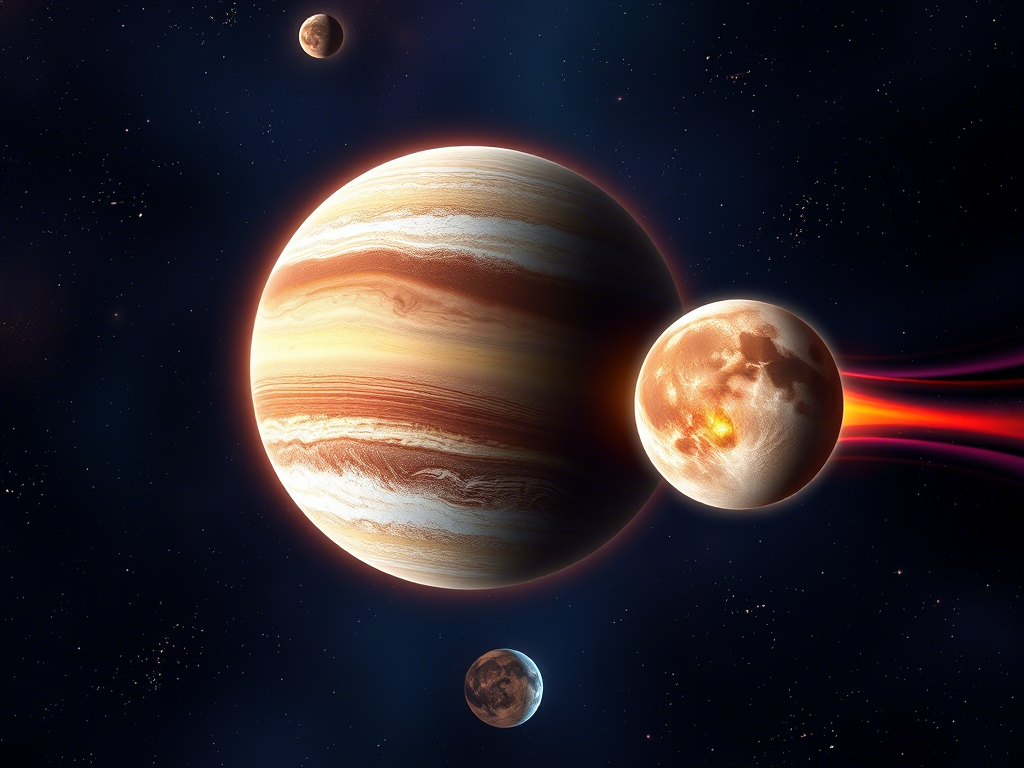
Pluto’s Atmosphere Is Changing the Color of Its Moon
Pluto’s atmosphere is far more than a thin veil of gas — it’s a dynamic system powered by haze. Tiny particles of nitrogen, methane, and carbon monoxide absorb sunlight, cool down, and then radiate heat, effectively controlling the dwarf planet’s entire energy balance.
New data from the James Webb Space Telescope (JWST) confirm that this process makes Pluto’s atmosphere unlike any other in our solar system. This “haze-driven” climate isn’t just fascinating in its own right — it could also offer clues about how early Earth managed to stay warm and habitable long before oxygen became a major part of our atmosphere.
Back then, Earth’s skies were filled with nitrogen and hydrocarbons, much like what we see today on Pluto. By studying how haze shapes Pluto’s climate, scientists hope to better understand the conditions that may have supported life in our planet’s distant past.
JWST Reveals Pluto’s Mysterious Surface Activity and Its Connection to Charon
New observations from NASA’s James Webb Space Telescope (JWST) are rewriting what we know about Pluto. The telescope has captured striking evidence of surface changes on the distant dwarf planet — including seasonal shifts in its icy terrain.
Even more surprising: scientists have found signs that particles from Pluto’s thin atmosphere are escaping into space and gradually settling onto Charon , its largest moon. This unusual transfer of atmospheric material between two celestial bodies has never been observed anywhere else in our solar system.
The findings are part of a new set of scientific studies released earlier this year by an international team of researchers. For planetary scientist Xi Zhang from the University of California, Santa Cruz, these results are particularly meaningful.
A recent paper published in Nature Astronomy on June 2 confirms a theory he proposed years ago — one based on data collected during NASA’s New Horizons mission in 2015.
At that time, Pluto had already lost its official “planet” status, but the flyby reignited global interest in this frozen world at the edge of our solar system. What New Horizons revealed was a surprisingly complex and active landscape — and JWST is now building on those discoveries in ways scientists hadn’t imagined.
From Skepticism to Scientific Breakthrough: The Rise of a Bold Idea
After the New Horizons mission sent back detailed data about Pluto’s atmosphere, planetary scientist Xi Zhang published a groundbreaking paper in 2017. In it, he proposed an idea that sounded almost unbelievable at the time: Pluto’s atmosphere isn’t just made of gases — it’s dominated by tiny haze particles unlike anything seen elsewhere in the solar system.
Zhang, now a professor of Earth and planetary sciences, argued that these microscopic particles play a major role in regulating Pluto’s temperature. They absorb heat from the Sun, then radiate it back into space, effectively managing the entire energy balance of the planet’s thin atmosphere.
“I remember people calling it a crazy idea,” Zhang admitted. Many of his colleagues were doubtful — after all, no other known atmosphere behaved quite like that. But the paper didn’t just present a theory; it made a clear, testable prediction: if this haze was indeed cooling Pluto, it should emit strong mid-infrared radiation — something future telescopes might one day detect.
That future arrived with the James Webb Space Telescope.
From Theory to Discovery: How JWST Proved a Pluto Prediction Right
The breakthrough moment came on December 25, 2021 , when NASA launched the James Webb Space Telescope (JWST) into orbit. This powerful observatory was exactly what scientists like Xi Zhang had been waiting for — a tool capable of detecting the faint mid-infrared signals his team had predicted years earlier.
Zhang explained that the recent study using JWST data was directly inspired by his 2017 paper. “We were incredibly proud,” he said, “because the observations confirmed our prediction in such a short time. In planetary science, it’s rare for a hypothesis to be validated so quickly — we feel both lucky and excited.”
A World Shrouded in Mystery
Pluto isn’t just a frozen rock drifting in the dark outskirts of our solar system — it’s a world of surprising complexity. The New Horizons flyby in 2015 revealed towering mountains, deep basins, and vast valleys carved not by water, but by glaciers made of nitrogen and methane ice.
Its atmosphere is unlike anything else we’ve seen — rich in nitrogen, methane, and carbon monoxide , and wrapped in a thick layer of organic haze formed through sunlight-driven chemical reactions. This kind of atmospheric chemistry is similar to what we see on Saturn’s moon Titan , making Pluto a unique natural laboratory for studying haze-dominated climates.
Meanwhile, Charon , Pluto’s largest moon, appears far less active. It lacks an atmosphere of its own and is covered mostly in water ice mixed with ammonia compounds. However, its striking reddish poles suggest something unusual is happening — and now, thanks to JWST, we know why.
Seeing Pluto and Charon in a New Light
Using the Mid-Infrared Instrument (MIRI) aboard JWST, scientists were able for the first time to measure the mid-infrared thermal emissions from both Pluto and Charon separately. These light curves — recorded at wavelengths of 18, 21, and 25 µm — gave researchers new insight into how heat moves across their surfaces.
In May 2023, MIRI also captured a high-resolution infrared spectrum (4.9–27 μm) of Pluto’s atmosphere. Because earlier instruments lacked the sensitivity to explore this range, the discovery revealed a surprising level of chemical complexity, helping scientists better understand how Pluto’s icy landscape evolves — and how its atmosphere interacts with Charon.
Unlocking Pluto’s Climate Secrets
The thermal data also showed changes in surface radiation as Pluto and Charon rotated. By comparing these measurements with climate models, scientists could determine key properties like thermal inertia, emissivity, and temperature variations across different regions.
These factors play a major role in shaping Pluto’s icy terrain and explain how atmospheric molecules gradually escape and settle onto Charon — a process never before observed in our solar system.
Even more exciting, the findings confirmed another scientific prediction — this time from Linfeng Wan , one of Zhang’s former Ph.D. students. His 2023 model accurately forecasted how Charon’s surface would reflect light based on Pluto’s atmospheric activity.
Cosmic Haze and Earth’s Distant Past
“Pluto gives us a unique opportunity to study how haze shapes planetary climates in extreme environments,” Zhang explained. He added that similar haze-rich atmospheres may exist on other distant worlds — like Neptune’s moon Triton and Saturn’s moon Titan — and that rethinking how they work could change our understanding of planetary evolution.
But perhaps the most fascinating implication lies even closer to home.
Before oxygen began accumulating in Earth’s atmosphere around 2.4 billion years ago , life already existed. Back then, our planet’s skies were filled with nitrogen and hydrocarbons — much like what we see today on Pluto.
By studying how haze regulates climate on Pluto, scientists hope to gain new insights into the conditions that allowed early Earth to remain habitable — and possibly how life got its start.
Looking Back to Understand the Future
Pluto sits at the edge of our solar system, yet it offers a window into the ancient past of our own planet. What once seemed like a wild idea has now helped scientists rethink how atmospheres behave — not just on distant worlds, but right here on Earth.
As Zhang put it:
“Pluto gives us a rare chance to explore how haze shapes climate in extreme conditions. And by doing so, we might be uncovering clues about the dawn of life itself.”
The findings were published on June 2, 2025 , in the journal Nature Astronomy , under the title:
“Evidence of haze control of Pluto’s atmospheric heat balance from JWST/MIRI thermal light curves.”
Led by researchers from the Laboratory for Instrumentation and Research in Astrophysics at the Paris Observatory and the University of Reims Champagne-Ardenne , the study brought together an international team of scientists including Tanguy Bertrand, Emmanuel Lellouch, Bryan Holler, John Stansberry, Ian Wong, Xi Zhang , and many others.
Professor Xi Zhang and his former Ph.D. student Linfeng Wan played a key role in developing the theoretical models used to interpret the data from JWST. Their work helped calculate Pluto’s thermal spectra and re-examine how fast its atmosphere cools — offering vital insight into how haze shapes planetary climates.
This research not only confirms long-held predictions but also opens new doors for studying other hazy worlds like Titan and Triton , and even Earth’s own atmospheric past.





